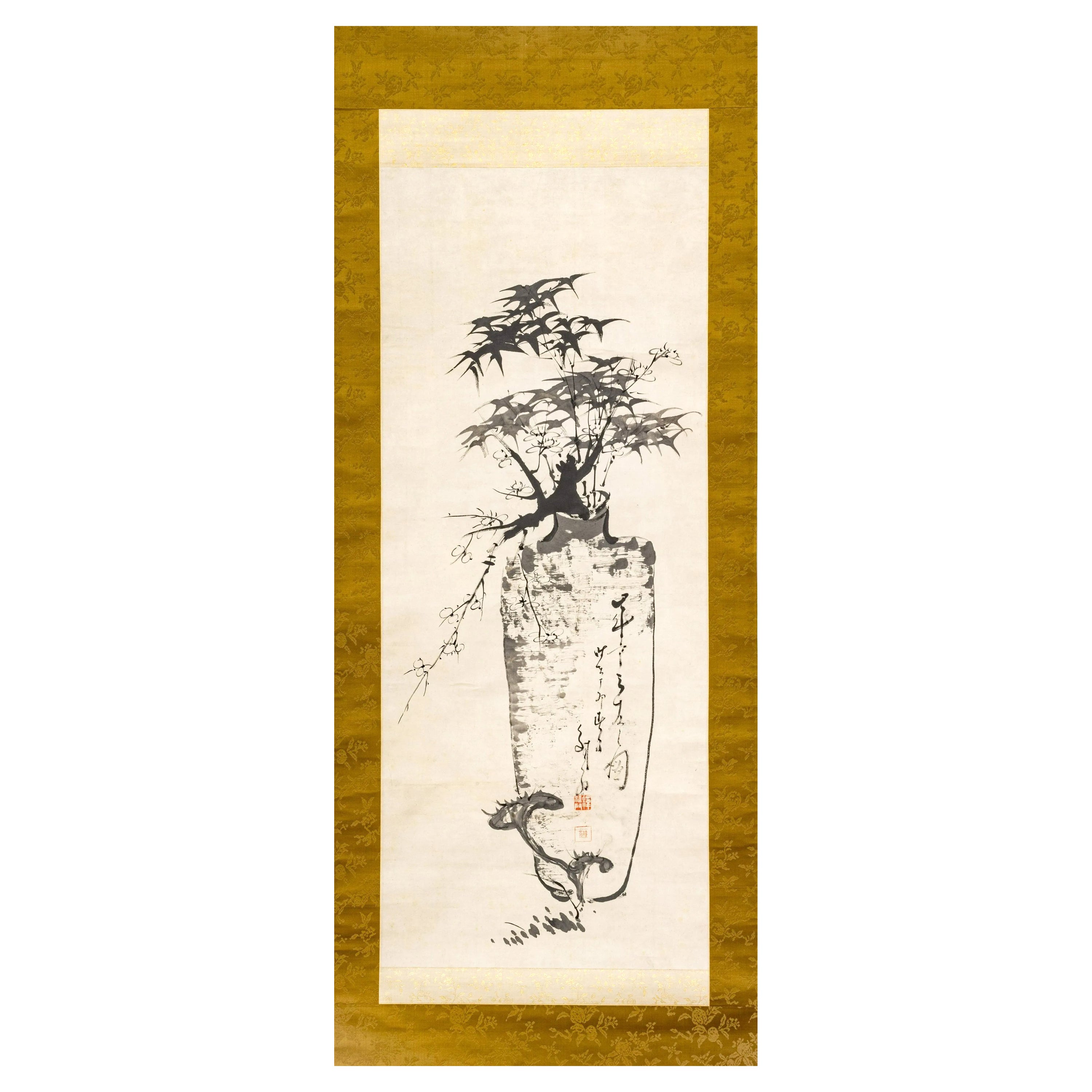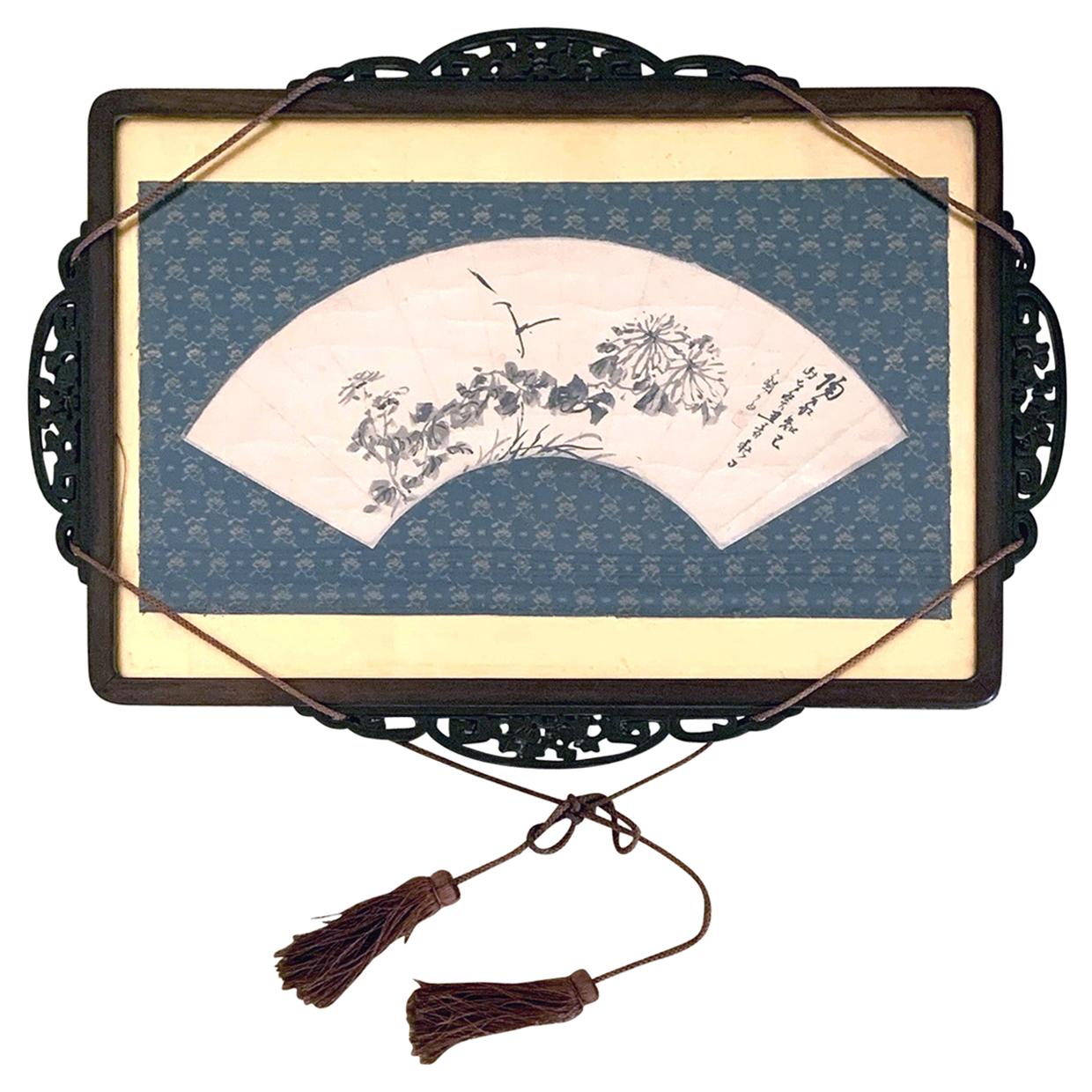Items Similar to Antique Japanese Ink Hanging Scroll Nakabayashi Chikuto Edo Period
Want more images or videos?
Request additional images or videos from the seller
1 of 18
Antique Japanese Ink Hanging Scroll Nakabayashi Chikuto Edo Period
About the Item
An ink painting on paper (Sumi-e) mounted with brocade borders as a hanging scroll. Entitled "Plum Blossom Under a Misty Moon", the artist was Japanese painter Nakabayashi Chikuto (1776-1853), accompanied by inscription of a composed complimentary poem by Nukina Kaioku (1778-1863). The nanga style painting (literati style) depicts a branch of Plum Blossoms in the snow under misty Moonlight. The work was dated to 1852, the year before the passing of the artist. The mastery of the use of ink was well demonstrated in this work, the strokes are bold, confident and effective, with negative spaces to realize the visuality of snow. Diluted ink was used in the background for the mist, surrounding a moon that again is an empty space. When hanging the scroll measures 70"h x 21.5"w. The size of the painting is 42.5" x 14".
The painting was mounted on a blue brocade background and comes in its original tomobako with ink inscription and several paper labels of the provenance. Same label was also affixed to the back of the scroll. The size of the tomobako is 23" x 3" x 3".
Provenance: Dawson's Book Shop, Los Angeles, California; Dr. Lenoir C. Wright, Greensboro, North Carolina; The Weatherspoon Art Museum, sold to benefit the acquisitions fund.
Reference. Similar ink painting of plum blossoms by the artist is in held in the collection in Los Angeles County Museum of Art (M.76.21.2). A painting with a comparable snow theme is in the collection of MET entitled Herons in the Snow (1975.268.108).
Born in Nagoya, Chikuto studied Chinese art and culture and his nanga style emulate Chinese ink paintings, especially works from the Yuan Dynasty and the techniques of Ni Zan. At the age of twenty, he opened his own studio in a small temple.
Kaioku, a contemporary of Chikuto, was also a painter and a leading figure in Chinese style calligraphy.
The plum flowers were adored by Chinese and Japanese literati for their delicate petals that bloom in cold weather. They represent a scholarly quality of strength and perseverance. The expressive painting highlights a branch of plum blossom in a geometrical form that was praised in one of the most famous and celebrated Chinese poem on plum blossom, written by Ling Bu in Song Dynasty. Covered in the dust of snow powders and under a half-revealed moon, the painting was enigmatic and full of literary reference. It was signed by Chikuto on the lower left side. The composed poem by Kaioku, written on the top right side was a word play inspired by Ling Bu's original lines. It was to praise the painter's ability to catch the true spirit of the plum blossoms.
- Creator:Hidaka Tetsuo (Artist)
- Dimensions:Height: 3.5 in (8.89 cm)Width: 27 in (68.58 cm)Depth: 3 in (7.62 cm)
- Style:Japonisme (Of the Period)
- Materials and Techniques:
- Place of Origin:
- Period:
- Date of Manufacture:19th Century
- Condition:Wear consistent with age and use. Fine condition, expect some mild surface creasing marks and minimal scattered foxing commonly found on antique scroll painting.
- Seller Location:Atlanta, GA
- Reference Number:1stDibs: LU945039063102
About the Seller
5.0
Platinum Seller
These expertly vetted sellers are 1stDibs' most experienced sellers and are rated highest by our customers.
Established in 2006
1stDibs seller since 2010
479 sales on 1stDibs
Typical response time: <1 hour
- ShippingRetrieving quote...Ships From: Atlanta, GA
- Return PolicyA return for this item may be initiated within 2 days of delivery.
More From This SellerView All
- Antique Japanese Ink Hanging Scroll Hidaka Tetsuo with Wood Storage BoxBy Hidaka TetsuoLocated in Atlanta, GAA hanging ink (Sumi-e) silk scroll by Japanese Zen artist Hidaka Tetsuo (1791-1871). Well presented in brocade boarders and mounted on paperback, this scroll depicts "Three Noble Friends in Winter" in a poetic and novel way. One of the favorite subjects by Chinese painters, the three noble friends in winter consists of pine, bamboo and plum flowers. They were admired for their characters of strength in cold resistance to remain evergreen and even blossom in unfavorable condition. The artist, however, composited the subjects in a none-conventional way as Ikebana. Bamboo and flowering plum branches were presented in an oversized pot...Category
Antique 19th Century Japanese Japonisme Paintings and Screens
MaterialsBrocade, Wood, Paper
- Pair of Japanese Ink Hanging Scrolls Kano TanyuBy Kano Tan'yu 1Located in Atlanta, GAA fine matching pair of hanging scrolls ink on paper mounted in green brocade borders circa Edo period (17-18th century). The Kano school painting depicts wild geese in the reeds by the margin of water, a popular subject borrowed from the Chinese tradition. Both painting were signed as Tanyu with a red seal of Morinobu, his birth name. The storage box is also present and was inscribed with the title Painting of Geese and Reeds and Kano Tanyu...Category
Antique Late 17th Century Japanese Japonisme Paintings and Screens
MaterialsWood, Paper
- Two Antique Japanese Hanging Scroll PaintingsLocated in Atlanta, GATwo Japanese scroll painting depicts scenes from the Tale of Genji (Genji-E), from Edo period. These painting were purchased from Odewara Shoten in the...Category
Antique Early 19th Century Japanese Japonisme Paintings and Screens
MaterialsBrocade, Paper
- Japanese Silk Scroll Painting of Moneys Edo Period Mori TetsuzanLocated in Atlanta, GAA Japanese mounted vertical hanging scroll painting by Mori Tetsuzan (Japanese, 1775-1841) circa 19th century Edo period. The watercolor and ink on silk ...Category
Antique 19th Century Japanese Japonisme Paintings and Screens
MaterialsSilk, Paper
- Framed Japanese Ink Painting Hidaka TetsuoBy Hidaka TetsuoLocated in Atlanta, GAAn ink painting on the fan surface by Japanese Zen artist Hidaka Tetsuo (1791-1871), now framed in a traditional Japanese carved wood frame with silk fabric mat and decorative hangin...Category
Antique 1850s Japanese Japonisme Paintings and Screens
MaterialsWood, Paper
- Antique Japanese Hanging Scroll Attributed to Iwasa MatabeiLocated in Atlanta, GAAn antique ink and color on paper hanging scroll (kakejiku) with brocade border. It appears to be a fragment of a larger hand scroll depicting a procession of a lord with his entoura...Category
Antique Early 17th Century Japanese Japonisme Paintings and Screens
MaterialsSilk, Paper
You May Also Like
- Antique hanging scroll of Japanese cat/Late Edo-Meiji period/Cat paintingLocated in Sammu-shi, ChibaThis is a picture of a cat drawn by a person named "Toshizumi Nitta" from the end of the Edo period to the beginning of the Meiji period. She is a very simple and cute cat. He is a vassal of the Tokugawa Shogunate, born in Ota City, Gunma Prefecture (southern part of Gunma Prefecture). He was related to the Tokugawa family and lived in a large mansion in the Ota clan in Gunma prefecture. However, the Nitta family's territory was very small, and they were by no means a wealthy vassal. He seems to have lived quite poorly. So he painted cats and sold them to people. The Nitta family continued to draw pictures of this cat for four generations. "Nitta toshizumi" is equivalent to the fourth generation. During the Edo period, sericulture was thriving in the Kanto region. Cats were said to be the gods of silkworms, as they drive away mice, the natural enemies of silkworms. It was the Nitta family who drew such a cat on paper, pasted it in the silkworm chamber, and sold it as a mouse repellent. There were also other monks who painted pictures of cats, but the Nitta family in particular was related to the Tokugawa family, so people believed that paintings of cats had special powers. , a lot of paintings...Category
Antique Late 19th Century Japanese Edo Paintings
MaterialsPaper
- Set of Four Japanese Silk Hanging Scrolls Screens C.1920Located in London, GBA stunning set of four Japanese silk mounted vertical hanging scrolls. Dating from C.1920 Taisho Period. The watercolour and ink on silk depicts a larg...Category
Vintage 1920s Japanese Japonisme Paintings and Screens
MaterialsSilk
- Hanging Scroll by Kamisaka Sekka, JapanLocated in Milano, ITThis painting represents a man waiting under a dark tree. The composition is extremely simple but suggestive. The artist, with few elements, can, in fact, create a vivid and dynamic scene, based on the tension between the strong ink stain that renders the tree and the elegant figure of the man, dressed in an aristocratic robe. Painter and designer, Kamisaka Sekka...Category
Early 20th Century Japanese Paintings and Screens
MaterialsPaper
- Large Antique Japanese Scroll Depicting a Nesting Crane, Taisho PeriodLocated in Prahran, VictoriaLarge and exceptional Japanese hanging scroll with a realistically painted depiction of a nesting crane by Yoshifuji Yoshio, Taisho/Showa perio...Category
Early 20th Century Japanese Taisho Paintings and Screens
MaterialsPaper, Silk
- Pair of Antique Japanese Paintings of Karashishi, Edo Period, 18th CenturyLocated in Prahran, VictoriaA rare pair of antique Japanese Karashishi paintings in a landscape of rocks and peony flowers on gold leaf ground in fine handmade frames, Edo period, early 18th century. The Karash...Category
Antique Early 18th Century Japanese Edo Paintings and Screens
MaterialsGold Leaf
- Japanese Edo Period Six Panel Screen of Chinese ScholarsLocated in Rio Vista, CAFascinating 19th century Japanese late Edo period six pane funpon screen. Large scale depicting Chinese scholars and officials engaged in leis...Category
Antique 19th Century Japanese Edo Paintings and Screens
MaterialsWood, Paper, Silk
Recently Viewed
View AllMore Ways To Browse
Japanese Screens Trees Flowers Birds
Chinese 4 Panel Silk Screen
Asian Fisherman Painting
Japanese Screen Garden
Chinese Ancient Screen
Pair 19th Century Rose Medallion
Leaf Table 4 Chairs
Tardy Clock
Antique Ceramic Charger
Leather Covered Bottles
Glass Sculptural Centrepiece
Iron Umbrella Italy
Sevres Marie
19th Century Continental Chairs
Persian Rugs 9by13
Chinese Stone Dog
Italian Nightstand 19th
Small Turquoise Lamps





